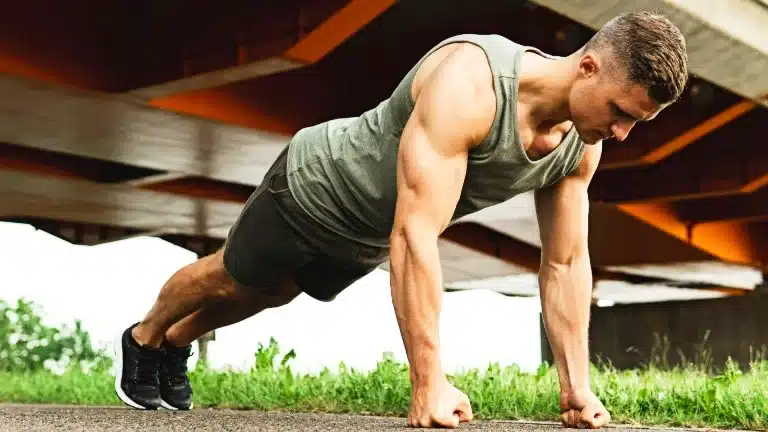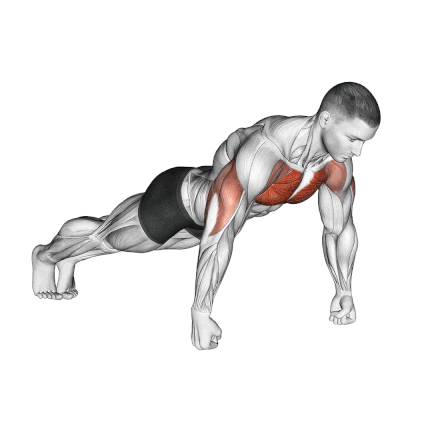Knuckle push-ups, also known as closed fist push-ups, are often part of strength and conditioning programs to build upper body strength and stability.
Some people may call it a “military push-up” because military personnel sometimes use it as part of their physical fitness.
Knuckle push-ups are similar to traditional push-ups but are performed with the hands in a closed-fist position (knuckles facing the ground). They are an effective way to train the chest, triceps, and shoulders and an excellent way to condition your knuckles, wrists, and forearm muscles.
Surprisingly, knuckle push-ups can be easier on your wrists than regular push-ups. The fist position puts your wrist in a more neutral alignment, reducing strain on the joint.
When I first started doing knuckle push-ups, I noticed a big difference in how my wrists and hands felt stronger over time. It was tough initially, but the rewards were well worth it.

- Knuckle Push-Ups Muscles Worked
- How to Do a Knuckle Push-Up
- Tips And Techniques
- Make Knuckle Push-Up Easier Or Harder (Variations)
- 1. Elevated Knuckle Push-Ups
- 2. Wide Grip Knuckle Push-ups
- 3. Close grip knuckle Push-Ups
- 4. One-armed Knuckle Push-Ups
- FAQs
- Are push-ups on knuckles better?
- Do knuckle push-ups strengthen your wrists?
- Are knuckle push-ups bad for your hands?
- How do knuckle push-ups affect knuckles?
- Can knuckle push-ups increase punching power?
- Are knuckle push-ups suitable for beginners?
Knuckle Push-Ups Muscles Worked
Knuckle push-ups target several muscles in the upper body, including:
- They primarily work the chest muscles (pectoralis major and minor), as well as the triceps and the front of the shoulders (anterior deltoids).
- They engage the core muscles, back muscles, and serratus anterior, which help stabilize the body during the exercise.
- Additionally, the muscles of the wrists, hands, and forearms are actively engaged as they work to maintain a stable fist position during knuckle push-ups.

Here’s how these muscles are engaged during the knuckle push-ups:
- Pectoralis major: This is the large muscle in the chest responsible for moving the arms and shoulders.
- Triceps brachii: responsible for extending the elbow joint.
- Anterior deltoid: responsible for flexing and rotating the arm.
- Serratus anterior: This muscle is located along the sides of the rib cage and is responsible for pulling the shoulder blades forward and upward.
- Coracobrachialis: This muscle is located in the upper arm and is responsible for moving the arm towards the body.
How to Do a Knuckle Push-Up

- First, make a fist. Yeah, like you’re about to punch someone.
- Make sure your knuckles are the part touching the ground. Pro tip: start on a soft surface like a yoga mat.
- Get Down into a plank position. Keep those fists directly under your shoulders. Your body should form a straight line from head to heels. If you’re new to this, it’s okay to start on your knees.
- Engage Everything (and I Mean Everything) Squeeze those glutes, tighten that core.
- The Descent: Lower yourself down slowly. I’m talking about slow-motion action movie scenes. Keep those elbows close to your body – we’re not trying to impersonate a chicken here.
- When your chest is about an inch from the ground, hold it for a second. Feel the burn? Good. That means it’s working.
- The Push Now, push yourself back up to the starting position. Exhale as you go up like you’re trying to blow out a stubborn birthday candle.
- Rinse and Repeat. Congratulations, you’ve done one. Now do it again. And again, until your arms feel like overcooked spaghetti.
Tips And Techniques
- keep your body straight, with your core tight and your elbows close to your sides. This will help you target the correct muscles and prevent injury.
- You should use a full range of motion to lower your body to the ground and allow your chest to touch the ground, and then push back to the starting position.
- Keep your hands shoulder-width apart. This will help to distribute the weight across your upper body evenly.
- If your knuckles are sensitive, start on a softer surface, like a mat or carpet.
- When making a fist, your wrists must be neutral, avoiding excessive bending or extension that could strain the wrists.
- Keep your fists closed tightly and your knuckles facing the ground. This will help properly engage the wrist and hand muscles and prevent your hands from slipping.
- If you are a beginner, you can perform the exercise on your knees rather than your toes.
- You can also increase the difficulty by adding additional reps or sets, or by using a resistance band or weight vest to add resistance.
- Start by doing 2–3 sets of 8–15 repetitions of the knuckle push-up. Your sets and repetitions should be based on your ability to maintain good technique throughout the entire set and reps.
- Follow training volume is the total work performed in a session or week.
| Level | Total Volume per Session | Sets | Reps per Set |
|---|---|---|---|
| Beginners | 30–50 reps | 2-3 sets | 10-15 reps |
| Intermediate | 50–200 reps | 3-4 sets | 20-50 reps |
| Advanced | 300 reps or more | 4-5 sets | 50-100+ reps |
Know More: Push-Ups: How-To, Muscle Worked, Benefit, Variations
Make Knuckle Push-Up Easier Or Harder (Variations)
Before attempting the knuckle push-up, ensure you have mastered the standard push-ups.
Standard push-ups are a great way to get comfortable with the motion required for a closed-fist or knuckle push-up. These exercises also strengthen your chest, triceps, and shoulders. Planks and mountain climbers increase stability and core strength,
You can use several modifications and variations to make your routine less or more challenging.
- If you are a beginner, you can modify the exercise by performing it on your knees rather than your toes or doing it on an elevated surface.
- To make push-ups harder, start by adding pauses at the top or bottom of each rep. You can also try increasing the speed at which you perform the motion for better endurance training.
- To add more resistance, try using a weighted vest or bands.
- Finally, if you want an even greater challenge, try single-arm knuckle push-ups.
1. Elevated Knuckle Push-Ups
The elevated knuckle push-up is a variation of the traditional knuckle push-up. In this workout, you place your knuckles on a higher platform, like a bench or step or floor.
Some people find that elevating their hands reduces wrist discomfort compared to performing push-ups on the floor.
2. Wide Grip Knuckle Push-ups
Wide grip knuckle push-ups involve placing your hands wider than shoulder-width apart on the ground.
A wider grip emphasizes the chest muscles, particularly the outer chest and the anterior deltoids.
3. Close grip knuckle Push-Ups
Close grip knuckle push-ups involve placing your hands closer together than shoulder-width apart on the ground.
The close grip emphasizes the triceps muscles, which make the arms stronger and more developed.
4. One-armed Knuckle Push-Ups
Traditional knuckle push-ups are challenging variations, as you have to perform the same with one arm.
This variation should only be attempted by those who have mastered proper form and have enough strength.
FAQs
Are push-ups on knuckles better?
The knuckle push-up is a variation of the regular push-up that can provide some extra benefits, but it is not necessarily better than regular push-ups.
Both exercises are effective at strengthening the chest, triceps, and shoulders, but knuckle push-ups place additional emphasis on the wrists, hands, and forearms.
Do knuckle push-ups strengthen your wrists?
Yes, knuckle push-ups can help strengthen the wrists. It helps develop wrist stability and strength over time by placing the weight on the knuckles instead of the palms.
Are knuckle push-ups bad for your hands?
Knuckle push-ups can put more stress on the knuckles and may cause discomfort or soreness, especially if done incorrectly or excessively. To avoid injury, it is important to build up strength slowly, keep your form, and listen to your body.
How do knuckle push-ups affect knuckles?
Regular practice of knuckle push-ups can toughen and strengthen the skin, tissues, and bones around the knuckles. However, excessive or improper push-ups can lead to bruising, discomfort, or even injury, so it’s essential to approach them cautiously.
Can knuckle push-ups increase punching power?
The knuckle push-ups can help increase punching power by strengthening and conditioning the wrists and knuckles.
However, numerous elements can influence punching strength, such as technique, general strength, and speed, so knuckle push-ups alone might not be the only decisive element.
Are knuckle push-ups suitable for beginners?
Knuckle push-ups are usually harder than regular push-ups and may not be good for beginners who don’t have enough strength in their wrists and upper body. Beginners should start with regular push-ups and move up to knuckle push-ups.
References
- Nadzalan, Ali & Mohamad, Muhamad & Shafiee, Mohd & Omar, Nur & Abd Malek, Nor & Janep, Mandra & abd karim, Zulakbal. (2021). Comparison of Muscle Activation between Traditional, Diamond and Knuckle Push Up Among Trained Men. Journal of Physics: Conference Series. 1874. 012016. 10.1088/1742-6596/1874/1/012016.

Manish brings over 10 years of hands-on experience in weight lifting and fat loss to fitness coaching. He specializes in gym-based training and has a lot of knowledge about exercise, lifting technique, biomechanics, and more.
Through “Fit Life Regime,” he generously shares the insights he’s gained over a decade in the field. His goal is to equip others with the knowledge to start their own fitness journey.
